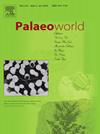Palaeoenvironmental implications of a turritelline-dominated assemblage from Upper Cretaceous carbonate rocks of Narmada Basin, India
IF 1.7
3区 地球科学
Q2 PALEONTOLOGY
引用次数: 0
Abstract
Turritelline-dominated assemblages (TDAs) occur in modern siliciclastic seas within shallow depths, under normal to below normal salinity, high nutrient flux, high ocean upwelling current and/or runoff and cool water conditions. Similar assemblages in carbonate sediments are rare in modern oceans. However, TDA in carbonate rocks are common during the Cretaceous. In this study, we report the presence of a TDA in the late Turonian Nodular Limestone Formation of the Bagh Group, Narmada Basin, central India. An unusually small species of Turritella, T. bardhani Halder, n. sp., is described from the TDA. The TDA, in terms of host rock microfacies and taphonomy, indicates shallow water to intertidal, low to moderate energy, eutrophic to mesotrophic conditions, that prevailed in restricted lagoonal to marginal lagoonal, back-reef environments. The turritellines, based on trace elements and Rare Earth Elements concentration, thrived under dysoxic conditions and experienced above-normal marine salinities. The preferences of modern TDAs do not fully represent such past ecological and lithological conditions, indicating an example of a non-uniformitarian shift in habitat.
印度纳尔马达盆地上白垩统碳酸盐岩中以绿松石为主的集合体对古环境的影响
在正常或低于正常盐度、高营养通量、高海洋上升流和/或径流以及低温水条件下,在浅海的现代硅质岩海洋中出现了以涡虫为主的集合体(TDAs)。碳酸盐沉积物中的类似组合在现代海洋中很少见。然而,白垩纪碳酸盐岩中的 TDA 却很常见。在这项研究中,我们报告了印度中部纳尔马达盆地巴格组晚期都龙纪结核石灰岩层中出现的 TDA。这是一种异常小的Ⅳ级物种。Halder,n. sp.,描述了该TDA。从宿主岩的微构造和岩石学角度来看,TDA 表明浅水至潮间带、低至中等能量、富营养化至中营养化的条件,普遍存在于有限的泻湖至边缘泻湖、后礁环境中。根据痕量元素和稀土元素的浓度,涡虫类在缺氧条件下生长旺盛,海洋盐度高于正常水平。现代 TDAs 的喜好并不完全代表过去的生态和岩性条件,这表明栖息地发生了非均匀性转变。
本文章由计算机程序翻译,如有差异,请以英文原文为准。
求助全文
约1分钟内获得全文
求助全文
来源期刊

Palaeoworld
PALEONTOLOGY-
CiteScore
4.00
自引率
5.90%
发文量
95
期刊介绍:
Palaeoworld is a peer-reviewed quarterly journal dedicated to the study of past life and its environment. We encourage submission of original manuscripts on all aspects of palaeontology and stratigraphy, comparisons of regional and global data in time and space, and results generated by interdisciplinary investigations in related fields. Some issues will be devoted entirely to a special theme whereas others will be composed of contributed articles. Palaeoworld is dedicated to serving a broad spectrum of geoscientists and palaeobiologists as well as serving as a resource for students in fields as diverse as palaeobiology, evolutionary biology, taxonomy and phylogeny, geobiology, historical geology, and palaeoenvironment.
Palaeoworld publishes original articles in the following areas:
•Phylogeny and taxonomic studies of all fossil groups
•Biostratigraphy, chemostratigraphy, chronostratigraphy
•Palaeoecology, palaeoenvironment and global changes throughout Earth history
•Tempo and mode of biological evolution
•Biological events in Earth history (e.g., extinctions, radiations)
•Ecosystem evolution
•Geobiology and molecular palaeobiology
•Palaeontological and stratigraphic methods
•Interdisciplinary studies focusing on fossils and strata
 求助内容:
求助内容: 应助结果提醒方式:
应助结果提醒方式:


